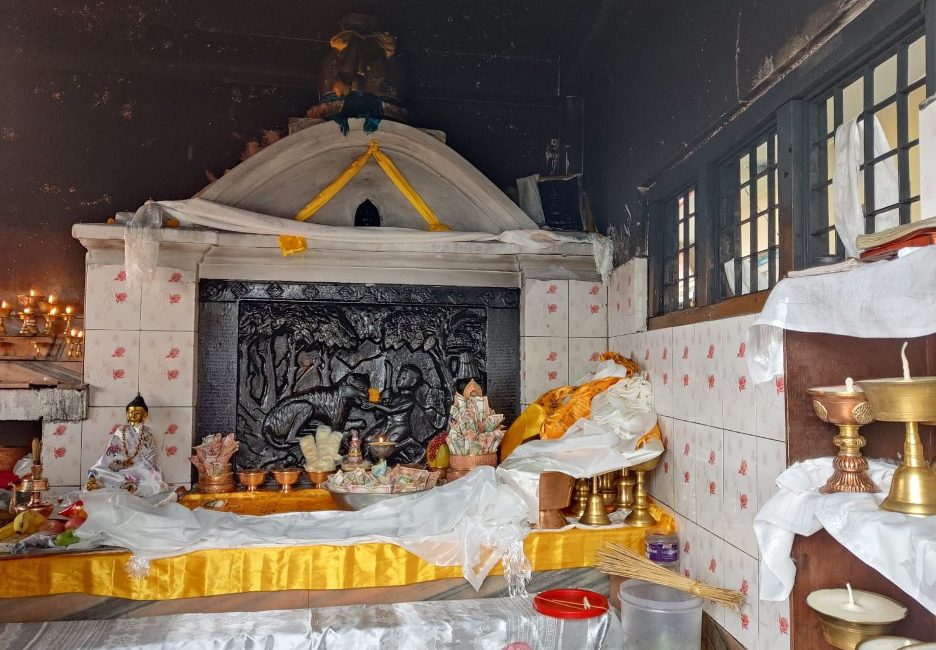By Anjana Timalsina
Anjana is a cultural heritage enthusiast who has worked in cultural heritage tourism. She is currently a member director of Patan Museum.
Namobuddha is one of the most significant sites for Buddhists in Nepal. Located in the Kavrepalanchok district of Lumbini province, approximately 40 kilometers from Kathmandu, the site features a stupa commemorating a figure called Mahasatva within a forest, and the cave where he sacrificed his own life for a tigress and her cubs. Currently, efforts are underway to develop Namobuddha into a major Buddhist pilgrimage and tourism destination outside the Kathmandu Valley. The Trangu Tashi Yangtse Monastery has played a significant role in preserving this pilgrimage site by teaching Vajrayana Buddhism and contributing to its conservation and activities.
Shakyamuni Buddha was born approximately 2,500 to 2,600 years ago in the garden of Lumbini. He is renowned for discovering and teaching the timeless Dharma, which liberates all beings. Following his Mahaparinirvana, his teachings evolved into the well-established and cosmopolitan religion known as Buddhism. Shakyamuni Buddha believed that every individual must attain enlightenment to extinguish their karma within this lifetime. Failure to achieve this would result in continuous rebirth in the never-ending cycle of sorrow. Buddha was able to articulate this philosophy to his followers because he had experienced it himself.
The Jataka tales recount numerous miracles and extraordinary events encountered by Shakyamuni Buddha. Among these, the Mahayana scripture, the Aryasuvarnaprabhasoktamasurendraraja, highlights a significant event and location in his life, which is not widely known.
The story describes that upon reaching Panchal Janapada with his disciples, Buddha was captivated by the beauty of the green grass, forests, and colorful flowers. Surrounded by thousands of followers, including Ananda, he asked Ananda to prepare his Asana in the forest and inquired if they wished to see the Astudhatu of a Bodhisattva who had sacrificed his life in an act of Mahadana. Buddha then touched the ground where he was seated, and immediately, a stupa made of gold, silver, and precious stones emerged before them. Shakyamuni Buddha instructed Ananda to open the stupa, revealing seven gold caskets containing Astu as white as snow or the Kumud flower. Ananda presented these Astu to Shakyamuni Buddha, who explained to the assembled Bhikshus that the Astu belonged to a great individual. All present bowed and joined their hands in reverence before the Astu.

Upon witnessing the miracle, Ananda inquired about the rightful owner of the Astu. Buddha then recounted the story of King Maharath and his three valiant sons: Mahapranad, Mahadev, and Mahasatva of Panchal Desh. During a hunting expedition in the jungle, they encountered an elderly tigress who had just given birth to five cubs. Mahapranad and Mahadev, frightened by the tigress, urged their youngest brother, Mahasatva, to return with them. However, Mahasatva refused, expressing his desire to assist the tigress and her cubs, as she was unable to hunt and provide food for her offspring.
After realizing that his brothers had left for home, Mahasatva sought a way to help the tigress. He concluded that only warm blood and fresh flesh would revive her. The prince then resolved to sacrifice himself for the tigress and her cubs, believing that aiding the tigress was his karmic duty in this life, which he was determined to fulfill.
Subsequently, Mahasatva proceeded to the cavern and self-inflicted a fatal wound to his neck. As blood cascaded over his form, he positioned himself adjacent to the tigress. The tigress, recognizing that the prince was not only liberating himself from mortal existence but also delivering her salvation, consumed all the blood from his form. Following this act, Mahasatva presented the tigress’s offspring with his own flesh for nourishment. The tigress and her young fully consumed Prince Mahasatva’s remains, leaving only skeletal remains.
Upon receiving intelligence of Mahasatva’s solitary presence in the wilderness, King Maharath embarked with both princes on a quest to locate him. Concurrently, his mother emerged from a distressing dream with a premonition of misfortune befalling her youngest son. Ultimately, all those in search discovered Mahasatva’s attire suspended on a tree proximate to the cavern. Delving further within, they encountered a harrowing scene: nothing remained of Mahasatva but his skeletal structure; he had departed life through an act of mahadana or great generosity, unparalleled by any other charitable deed. In honor of this sacrifice, the king commissioned a stupa constructed from seven precious metals to enshrine Mahasatva’s relics. It is believed that after countless years this benevolent deed may guide all earthly beings towards enlightenment and Buddha.
While recounting the entire story to his disciple, Shakyamuni Buddha found himself reliving past moments. During this narration, Ananda inquired about how the Buddha knew this story and his connection to the place. Shakyamuni Buddha then revealed that he had been born as Mahasatva thousands of years ago and, through the act of Mahadana, was later reborn as Siddhartha Gautama in Lumbini.
Namobuddha is revered by both Buddhists and Hindus in Nepal. However, the story behind its significance is not widely known. The site holds equal importance to followers of Buddha as Lumbini and Ramagrama, making it a priority destination for local and international pilgrims alike.


